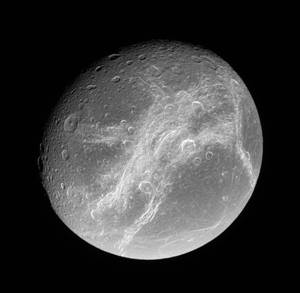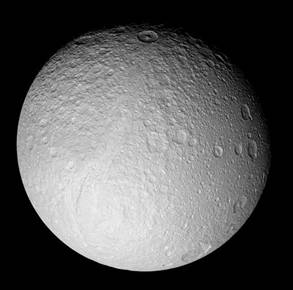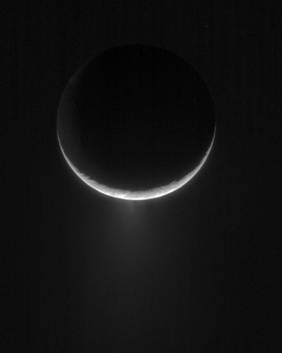17 June 2007

Dione (1,126 km across)
Credit: NASA/JPL/Space Science Institute

Tethys (1,071 km across)
Credit: NASA/JPL/Space Science Institute
According to recent measurements from the Saturn-bound Cassini spacecraft, Saturn's moons Tethys and Dione are hurling streams of plasma (electrically-charged gas) into space. The discovery hints at the possibility of some phenomenon of geological activity, perhaps even volcanic, on these small icy moons. Before this startling discovery, only Titan, Saturn's largest moon, and volcanic Enceladus were known to be active.
These findings were published in Nature. The Cassini mission is a cooperative project of NASA, the European Space Agency (ESA) and the Italian Space Agency (ASI).
These plasma flows were traced to Tethys and Dione because of the energetic outward movement of electrically-charged gas, which could be mapped back to the moons' orbits in the magnetic environment of Saturn. The gas consists of negatively-charged electrons and positively-charged ions, which are atoms, stripped of one or more electrons. Due to their electric charge, the electrons and ions can become trapped inside a magnetic field.
Saturn rotates in 10 hours and 46 minutes. Therefore, the magnetic field and the trapped plasma are sweeping through space, and a force is exerted on the plasma, trying to fling the gas outwards, away from the center of rotation.
Soon after the Cassini spacecraft reached Saturn in July 2004, its instruments revealed that the planet's fast axial rotation squashes the plasma into a disc, and that great fingers of gas are being thrown out into space from the disc's outer edges. Hotter, less dense plasma then rushes in to fill the gaps.
The Cassini Plasma Spectrometer team has made a careful study of these phenomena applying their instrument. They have found that the direction of the ejected electrons points back towards Tethys and Dione. "It establishes Tethys and Dione as important sources of plasma in Saturn's magnetosphere," stated team member Jim Burch, of the Southwest Research Institute (SwRI).

Plume of icy material erupting from Enceladus (505 km across)
Credit: NASA/JPL/Space Science Institute
The activity on Enceladus was detected first by Cassini's Dual Technique Magnetometer. This led the flight team to schedule a particularly close pass of Enceladus, which revealed a wealth of data about Enceladus' alien geysers , and spectacular pictures, too.
"The best results arise when we combine a variety of data sets to understand the observations," said Michele Dougherty, Principal Investigator of the magnetometer.
Future flybys of Dione and Tethys will yield close-up looks of the moons. The teams will inspect the data acquired during the Tethys and Dione flybys of 2005 for further signs of activity.
They will also try to determine the composition of the plasma using ion data.
Further Reading
Official Cassini-Huygens Websites
http://www.nasa.gov/cassini
http://saturn.jpl.nasa.gov
http://saturn.esa.int .
Aymen Mohamed Ibrahem
Senior Astronomy Specialist